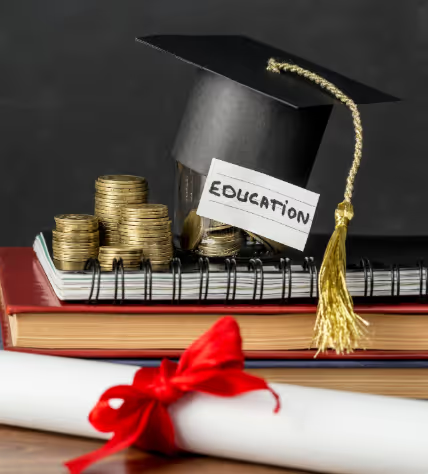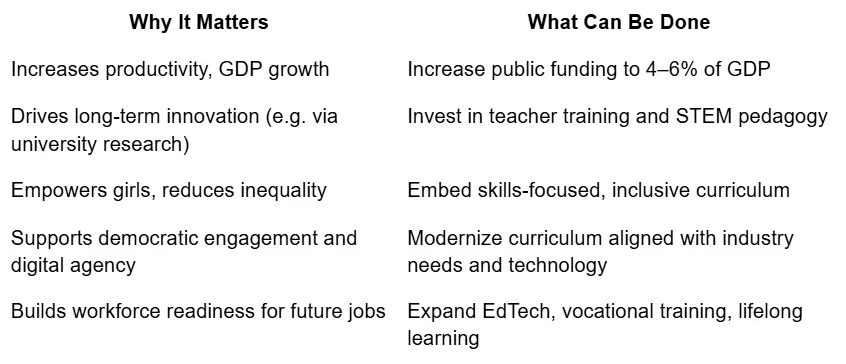Stay informed with our newsletter.
.webp)

.webp)

Investing in education is crucial for building strong economies, reducing inequality, and preparing societies for the future. Quality education drives innovation, empowers individuals, and fosters social cohesion. Despite its importance, many regions face underfunding, outdated systems, and skill gaps. Strategic actions, such as increasing public funding, modernizing curricula, training teachers, and leveraging technology can transform education. With collective effort, education can become a powerful tool to unlock human potential and drive sustainable development worldwide.

In recent months, global leaders and educators have intensified calls to prioritize education investment not merely as a moral imperative but as a foundational driver of economic resilience, innovation, and social progress. From teacher training initiatives in India to surging university demand in Australia, the case for greater investment has never felt more pressing.
According to the OECD’s Economic Outlook (February 2024), bolstering human capital through education spending is essential to counter slow productivity growth, ageing populations, and the climate transition. Declining PISA performance across many countries signals a long-term threat to economic growth, without quality education, productivity stagnates.
Moreover, global research confirms that every year of additional schooling increases individual earnings by about 9–13%, and contributes up to 18% to national GDP. Returns are especially high for secondary and tertiary education, often 10–15% per year of schooling.
Education as an Innovation Engine
The World Bank notes that investment in higher education, particularly doctoral training, yields long-term innovation far more sustainably than short-term R&D subsidies. By cultivating deep skills and research capacity, nations can spawn breakthroughs in technology, healthcare, and sustainability
Investing in girls’ education offers some of the highest returns in development economics. Each additional year of schooling for girls increases their earnings by 10–20%, reduces early marriage, improves maternal and child health and boosts overall societal well‑being. Some studies estimate that such investment alone can raise GDP growth rates by up to 1.5%.
Democracy, Inclusion, and Social Cohesion
Education fosters civic engagement, digital literacy, and critical thinking, essential tools in today’s era of misinformation and global shifts toward authoritarianism. Well-educated young people are more likely to participate in democratic processes and build inclusive communities.
Inclusive education, targeting children irrespective of gender, socioeconomic status, or disability, further promotes social mobility and reduces disparities across generations.
In Udupi, Karnataka, a recent Shell NXplorers initiative trained 18 Atal Tinkering Lab teachers in sustainable, STEM-based pedagogy supported by NITI Aayog’s Atal Innovation Mission. This training enables local educators to mentor students on real‑world problem-solving and innovation-based projects.
This model underscores how investing in teacher capacity-building unlocks student creativity and real-world relevance, especially in rural or under-resourced contexts.
Western Sydney is projected to see an 84% increase in demand for tertiary degrees by 2050, driven by population growth and shifting economic needs, especially in fields like education, health, IT, and green technologies. The region currently faces shortages of teachers, nurses, and tech workers, highlighting the urgent need for systemwide scaling.
In Midland, Michigan, a public bond proposal gained backing from local residents who see school modernization, expanded pre‑K, and improved school safety not as costs but as investments in regional future and student outcomes.
UK education leaders urged a curriculum overhaul to align with the digital and AI era. Reform proposals include reducing age‑16 exams, introducing a broader British baccalaureate at 18, and creating technical sixth forms linked to industry needs. These reforms aim to prioritize creativity, numeracy, and real-world readiness.
1. Economic Resilience: Robust education systems build skilled workers, spur innovation, and ensure sustainable growth even in economic downturns.
2. Societal Inclusion: Educated populations are healthier, more civically engaged, and equipped to reduce inequalities across gender, region, and class.
3. Global Adaptability: As AI, digital trends, and climate change shape society, education systems must evolve to train critical thinkers and adaptive leaders.
If current trajectories hold, national budgets, international aid, and private investments could converge to fund the transformation needed, supporting equitable access, innovation-driven teaching, and lifelong opportunity. But the window is now: the choices governments, educators, and communities make today will define the workforce, social fabric, and democratic strength of 2040 and beyond.
Policymakers must commit to bold public investments, stronger education budgeting, and linking spending to outcomes.
Educators and Schools should embrace innovation, teacher training, early childhood focus, and project-based learning tied to real-world challenges.
Private Sector and Philanthropy can scale EdTech, sponsor STEM programs, support inclusion initiatives, and co-design curricula with schools.
Communities and Parents must advocate for modern education systems that prepare children not just for exams, but for life, work, and responsible citizenship.
We must stop treating education as a line-item in yearly budgets. Instead, view it as a compounding investment in human potential, one that delivers exponential returns across economic, social, and global dimensions.

In today’s fast-changing world, investing in quality education is not optional, it’s essential. The mandate is clear. The opportunity is immense. The future belongs to societies that learn, adapt, and invest, starting now.
For questions or comments write to contactus@bostonbrandmedia.com
